Ricky Monahan Brown's Blog, page 4
October 31, 2018
Political Football
In recent days, I’ve been cutting down on my consumption of BBC Radio. I think that it’s incumbent upon the responsible citizen to keep themselves informed so they can participate in democracy, but I’m increasingly unsure that listening to Today or Good Morning Scotland or The World At One or PM is a good way to do that. Particularly now Eddie Mair has moved on.
BBC asking if fascist Bolsonaro – whose rise, many have commented, was facilitated by frequent & normalising media appearances – is 'a refreshing break from political correctness'. (Tweet now deleted). pic.twitter.com/bxHWH6wU9e
— Edward Anderson (@edanderson101) October 29, 2018
Stick with me – there’s
fitba and a bangin choon at the end of this one
Check the Apoplexy Tiny Letter for a soundtrack to keep you going to the bottom of the page.
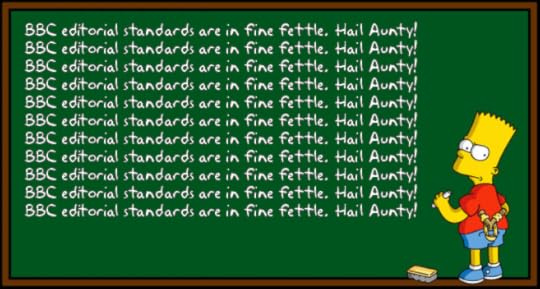 There’s no arguing with that. Do you hear me? No. Arguing.
There’s no arguing with that. Do you hear me? No. Arguing.Here‘s Nick Robinson defending Today’s interview with Ann Coulter at the end of last year, wherein she defends Donald Trump’s retweet of the deputy leader of a British fascist organisation. And here‘s a recent report on Today shedding around a tenth of its listenership in the past year.
 The deputy leader of a British fascist organisation. And Nick Robinson. AH-HAHAHAHAHA!
The deputy leader of a British fascist organisation. And Nick Robinson. AH-HAHAHAHAHA!So it was a relief to hear a truly lovely piece of radio from one of Aunty’s well-paid presenters a few days ago. Gary Lineker – former England captain, their highest scorer in World Cups, winner of the Golden Boot at Mexico ’86, and European Cup Winners’ Cup winner with Barcelona – was asked to share his reaction to the death of Leicester City FC owner Vichai Srivaddhanaprabha this past weekend on the 606 call-in programme.
People ask me ‘What is the greatest sporting moment of your life?’ It is Leicester winning the league [over twenty years after Lineker retired].
I have played lots of sport and lots of World Cups but nothing matched that. It made me cry and still cry now. That wouldn’t have been possible without Vichai.
 Gary promised to present Match Of The Day in his pants if Leicester won the league
Gary promised to present Match Of The Day in his pants if Leicester won the leagueHe was choking up as he related the story, and for a second, my faith in football was restored. One might have thought that Aberdeen‘s victory over Rangers in the Scottish League Cup semi-final on Sunday would have done that already. I’m tired of Scottish football, though.
100% this. I’d like to inculcate in the wee man the dubious joys of Scottish fitba, but why would I teach him to accept abusive behaviour from a bunch of #SPFL or #SFA wallopers? I’d rather teach him self respect. #BetfredCup https://t.co/qmAngmyHsT
— Ricky Monahan Brown (@ricky_ballboy) September 29, 2018
We don’t have time to dwell on the myriad failures of the Scottish Professional Football League or the Scottish Football Association. Like, seriously. We only have 12 years to limit climate change catastrophe.
But since we’re here…. Only in Scotland’s Mafia-like football establishment could it be controversial that the two teams in a cup final get an equal split of the tickets for the game.
Aberdeen demanding 50-50 split of tickets for Betfred Cup final with Celtic at Hampden https://t.co/4a9hBdDgX5 pic.twitter.com/AbwMqIGclo
— EveningExpress Sport (@ee_sport) October 29, 2018
Still, don’t worry if you can’t get a ticket to a big game at the much-derided national stadium, there’s always Aunty to… Oh. Hold on.
Wonder why @BBCSportscene just aired without showing highlights of today’s two massive league cup semis ? Because £350M is raised from Scottish TV licences and only £85M is spent on Scottish content. That’s why.
—
October 17, 2018
Tour de France
For some reason, I was thinking the other day that I’ve “only” ever been to France once.
 “Hey, look! They’ve got the same editorial team as BBC News!“
“Hey, look! They’ve got the same editorial team as BBC News!“And I was thinking, maybe I should try to fix that while I still can.
[My whimsy’s just about been extinguished, tbh. Find the last of it in the Apoplexy Tiny Letter]
That one time was a school trip around the end of junior school/beginning of secondary school. We were up in Normandy, staying in a youth hostel. Of course we visited the D-Day beaches.
 “A zip-line would have been quicker! Then a quick bridge to Ireland to take care of the Paddies! Tally-ho!”
“A zip-line would have been quicker! Then a quick bridge to Ireland to take care of the Paddies! Tally-ho!”Yeah, Johnson, it’ll be like Garden Bridge. But like, x10. (I’m not calling him Boris. We’re not mates.)
I also remember a cracking market where we learned the basics of negotiating with mainland Europeans, as citizens of the UK.

– Ca, c’est combien?
– Cent francs.
– I’ll give you fifty.
– Cent francs, enfant Britannique stupide.
October 10, 2018
Making Everything Better
Hi there!
I’m aware that the posting schedule here at apoplectic.me has been a bit erratic recently. Sorry about that.
 Erratic? I’ll show ye erratic, sonny – Thom Yorke
Erratic? I’ll show ye erratic, sonny – Thom YorkeIf you’re of a mind to follow me on the tweetie box or like and follow my writer’s page on Facebook or sign up for the Apoplexy Tiny Letter, the excuse for this will be revealed early on Thursday afternoon, Edinburgh time.
In the meantime, let’s stick to the stroke news, shall we?
Long-suffering readers will be aware of my recent appearance on the news here in Scotland, talking about my experience of stroke and promoting the British Heart Foundation‘s recent research into comorbidity.
https://twitter.com/ricky_ballboy/sta...
IT’S THAT MAN AFF THE TELLY!!!
Unrelatedly – you would think – I was off at a night of poetry, storytelling and song with a distinctly Scottish feel a week-and-a-half ago. So much so, that the pub hosting the event claims to have been the Edinburgh base for Billy Connolly’s early shows in the city as part of the folk group The Humblebums with Tam Harvey and Gerry Rafferty (of Baker Street fame).
It’s true. The sax solo from Baker Street does improve any song .
Billy Connolly was mentioned on the news here earlier in the week because it was a useful distraction from Brexit he’s been in touch with scientists at Harvard University regarding the possibility of him being a “guinea pig” for research into stem cell treatment for Parkinson’s disease.
That seemed to me to be a weird kind of non-story, but he does have a book to sell, and reading more of the related article here revealed some interesting titbits.
 Oh, d’ye bloody think so?!
Oh, d’ye bloody think so?!For starters, Connolly was diagnosed with prostate cancer – for which he had successful surgery – in the same week he was told he had Parkinson’s in 2013. Which, to be fair, is kind of a Royal Flush to my Full House of losing my job and having my brain explode in the same weekend.
 HAHAHAHAHA! 1-0, sonny!
HAHAHAHAHA! 1-0, sonny!More importantly, it puts me in mind again of that whole comorbidity thing. I mean, sure, maybe it’s just yer age, duck – but check out this new news from the new news news desk:
Half of women ‘will develop dementia or Parkinson’s or have a stroke’
And after that, the article really becomes a downer. So, what should we do? Eat, drink, and be merry while we have the chance?
[image error]“Mibbes aye. But then, mibbes naw.”
Well, quite. On the one hand, apoplectic.me is all for living in the moment. But on the other, the drink’s a terrible thing. Besides, this research from the University Medical Center Rotterdam in the Netherlands isn’t meant to be a total downer.
Certainly, it confirms the risk of comorbidity associated with certain diseases. And it does highlight the issue that while
[I]n middle age, there is a great deal of focus on heart disease and cancer…, diseases of the brain in later life get less attention and are less researched
 “But being middle-aged is as awesome as being on my period,” says man (53)
“But being middle-aged is as awesome as being on my period,” says man (53)Hopefully, the study will add to the impetus to increase efforts to find a drug to delay the onset of dementia symptoms. The researchers also said that preventive measures could substantially reduce the burden of the illnesses.
Dr Carol Routledge, director of research at Alzheimer’s Research UK, said
The best current evidence suggests that eating a balanced diet, controlling our weight, staying physically active, not smoking, only drinking within the recommended limits and keeping blood pressure and cholesterol in check are all associated with better brain health into old age.
I’ve got to say, I’ve found that not keeping your blood pressure in check and not staying physically active are Very Bad Things, so that all sounds like good advice. Till next time…
 Cheers!
Cheers!Share this:





September 20, 2018
Modus Operandi
So, the last post here on apoplectic.me cast a pretty sneering eye over Public Health England’s Heart Age Calculator. And if you think that an eye can’t sneer, welcome to the stroke blog.
 ‘Aren’t you a bit young for this, sonny?’
‘Aren’t you a bit young for this, sonny?’That’s pretty much the modus operandi around here – bitter cynicism leavened with fun. Skip down to the bottom of this post if you just want to hear some of the best Scottish pop ever.
But it turns out that this time, I wasn’t alone in my cynicism.
[Maybe there’s actual upbeat stuff in the Apoplexy Tiny Letter – check it out]
That scourge of the online scoundrel and guardian of The Truth, Aunty Beeb, was on the job in the shape of More Or Less, the show in which Tim Harford and the team
It’s pretty good stuff, and they do a podcast, too. It turns out that in the aftermath of Public Health England doing their thing, a bunch of listeners – cool people like me, I assume – got in touch to express their scepticism regarding the Heart Age Calculator.
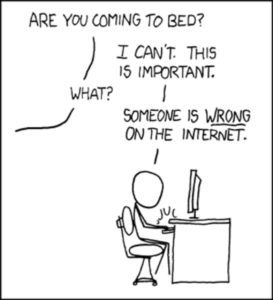 You might want to watch your blood pressure, Big Guy
You might want to watch your blood pressure, Big GuyBy the time More Or Less was on air on 9th September, the online questionnaire had been taken more than 1.9 million times. And a lot of the participants didn’t think their results felt right. It turns out that if you don’t know your blood pressure or cholesterol numbers, the calculator assumes that you’re running at risky levels, because the average English person does have high numbers in each of these regards.
 HOW DARE YOU GENERALISE ACROSS A NATION IN YOUR HEALTH-RELATED OBSERVATIONS?!?!
HOW DARE YOU GENERALISE ACROSS A NATION IN YOUR HEALTH-RELATED OBSERVATIONS?!?!The peer-reviewed open access medical journal BMJ Open observed that 50% of the participants don’t know these answers.
To make things worse for Mr Angry up there, More Or Less only then went to a GP and writer on health issues from Glasgow – Dr Margaret McCarthy – to discuss what was up with all this. Things went Glesca pretty quickly.
“This device is a major fail.”
 “Also, A’m fae Leith. Tosser.”
“Also, A’m fae Leith. Tosser.”She goes on to enlarge on this observation, pointing out that the calculator doesn’t ask about diet or exercise, is based on a tool used in GPs’ offices and hospitals where people have access to these numbers, and hasn’t been tested?!?!?!
Further, the tool advises people under 40 to go and get their blood pressure and cholesterol tested, and this is not Public Health England’s actual advice, “because taking treatment in this age group is unlikely to make any difference to your wellbeing or lifespan.”
 “Untrue. My instructions were quite clear” – A. Doctor, MBBS
“Untrue. My instructions were quite clear” – A. Doctor, MBBSThe More Or Less segment wraps up by stating that rather than making vague noises about raising awareness, it would be better to treat people like grown up adults. As opposed to infant adults, I guess.
If we lose trust in the information we’re given, that may have all sorts of consequences elsewhere.
But surely treating people like idiots can’t have such terrible consequences?
 Well, I’m sure I don’t know what you’re talking about. Sounds like FAKE NEWS. SAD.
Well, I’m sure I don’t know what you’re talking about. Sounds like FAKE NEWS. SAD.EPILOGUE
Hi, Long-Suffering Reader. Thanks for sticking with it.
Towards the end of the comments thread to the original Young At Heat post, Long-Suffering Reader Of The Blog Marcelo and I got to chatting about the best Scottish albums out there. I remarked
if you sat an infinite number of Stroke Blokes in front of an infinite number of computers for an infinite amount of time and told them to come up with their top ten Scottish albums, they’d probably hit on that list by lunchtime. Except they’d still only be pretending to get The Blue Nile. My list as of 22:45 on 19/9/18 in this week’s post.
And here it is. Followed by the 22:46 version. Both in alphabetical order by artist name. I’d love to know what your favourite Scottish album is.
Lemme know in the comments, wontcha?
Stroke Bloke’s Top Ten Scottish Albums, v.1
1. ballboy: a guide for the daylight hours – even though it doesn’t include this deathless classic
2. Edwyn Collins: Losing Sleep
3. The Delgados: The Great Eastern
4. Franz Ferdinand: Franz Ferdinand
5. Mogwai: Mogwai Young Team
6. Primal Scream: XTRMNTR
7. Simple Minds: Sons and Fascination/Sister Feelings Call
8. Slam: Alien Radio
9. The Trash Can Sinatras: I’ve Seen Everything
10. Young Fathers: White Men Are Black Men Too
Stroke Bloke’s Top Ten Scottish Albums, v.2
1. Belle and Sebastian: Tigermilk
2. Big Country: The Crossing – even though it doesn’t include this deathless classic
3. Boards of Canada: Music Has The Right To Children
4. Idlewild: The Remote Part
5. Jesus And Mary Chain: Honey’s Dead
6. Lloyd Cole and The Commotions: Rattlesnakes
7. Nectarine No.9: Sea With Three Stars
8. The Proclaimers: Hit The Highway
9. Teenage Fanclub: Grand Prix
10. Travis: Good Feeling
Share this:





September 6, 2018
Young At Heart
Mrs Stroke Bloke and I have been catching up with the BBC Scotland documentary series Rip It Up: The History Of Scottish Pop.
In a sufficiently leisurely fashion that we haven’t reached this yet:
A deathless classic, I’m sure you’ll agree.
[For the most leisurely stroll through Scottish pop possible, check the Apoplexy Tiny Letter.]
It’s good to be young at heart. I know this, because I’ve recently read that Public Health England has found that
 ‘Tell me about it. I’m seven!’ – Benjamin Button
‘Tell me about it. I’m seven!’ – Benjamin ButtonDoesn’t that mean that one in five adults is fortunate enough to have a heart that is less damaged than it should be at their age, meaning they should be congratulated?
In any event, study is a pretty hifalutin word here, because what they seem to be talking about is a bunch of people completing an online test which will then calculate their “heart age”. You can have a go at the link above, if you’re so-minded.
Obviously, I had a shot because I’m a morbid goth at heart and my impending death entertains me.
 Andrew Eldritch in 1987: heart age 3,692, chronological age 28
Andrew Eldritch in 1987: heart age 3,692, chronological age 28It turns out that, given my history of stroke, the heart age calculator claims not to work for me. But I played with my answers to wring a result out of the thing anyway, and it turns out that my heart gave up the ghost and I died about six years ago.
Uncanny, eh?
 Well, it’s a bit bloody late for that, dontcha think?!
Well, it’s a bit bloody late for that, dontcha think?!Aye, there’s the rub. I’m sure that what Public Health England is trying to do here is, make people stop and think about their heart health and what they’re doing about it. Give them a right good scare and frighten them into behaving properly.
However, as long-suffering readers may be aware, I’m behaving so well that the local practice nurse has to make up some rubbish about mackerel in order in order to make my blood pressure monitoring appointment worthwhile. And still this online tool tells me that if I’m not dead already, my heart is even older than my chronological age.
 HAHAHAHA! How is that even possible?
HAHAHAHA! How is that even possible?If that’s the case, I might as well enjoy the few minutes I have left by lacing a filterless Lucky Strike with heroin, putting it in the blender with some liquid LSD, and injecting it directly into my eyeballs.
But y’see, here’s the funny thing. My heart may be made of cracked, millions of years old sandstone, but I do feel young at heart. Although my brush with death may have cured my fear of death, I still want to hang around and do more stuff.
 C’mon, do something
C’mon, do somethingSo while – in my case – having Public Health England try to scare the shit out of me is kinda counterproductive, having a young metaphorical heart seems like it might be helpful. I mean, I’ve already done all the dumb stuff I shouldn’t have done. Why don’t we look forward with a sense of purpose and optimism?
I was recently telling someone about Claudia Hammond’s theory of the reminiscence bump, and they were kind of interested by it. I’d recommend revisiting this post if you’re not familiar with it. But, long story short, novelty keeps you young.
 Oh god, I feel OLD
Oh god, I feel OLDFunnily enough, it turns out that The Bluebells set a good example in that regard. Lawrence Donegan went on to be the bassist with Stroke Bloke favourites Lloyd Cole and The Commotions, and a golfing correspondent with The Grauniad. The less said about his stint as House of Commons assistant to Brian Wilson MP, the better.
David McCluskey uses music therapeutically with a wide variety of people which, unsurprisingly, apoplectic.me supports wholeheartedly. Sometime member Craig Gannon was also a sometime Smith, including on this M********-free track.
 Then this happened…
Then this happened…The Bluebells got involved with another apoplectic.me bête noire, Volkswagen, when Young At Heart was used for a TV advert. All’s well that ends well, though. The re-issued single hit number one for four weeks in 1993, and the band reformed again in late 2008-early 2009 to support apoplectic.me hero Edwyn Collins at a show in Glasgow.
Doesn’t the very thought make you feel young and alive?
Oh god, no.
Share this:





August 28, 2018
Where Are We NOW?
We’re at the fag-end of August, almost six years after the moment that set off the series of events that would change Mrs Stroke Bloke’s and my life forever. But no doubt we’ll get to that in due course.
For now, the Edinburgh Festival has just finished and the smell of sulphur from the massive closing fireworks display that rattled our windows last night is fading.
 ‘What? No, that was just me running my venue.’
‘What? No, that was just me running my venue.’[Check out the Apoplexy Tiny Letter, where the devil always has the best tunes.]
Towards the beginning of the month, I attended a filming of the news and discussion show Scotia (hosted by Robert J Somynne and Michael Gray and produced by the indefatigable Phantom Power) that included coverage of whether, if, and how the Festival works for the city, its citizens, the artists, and the workers.
My joy at returning to an Edinburgh that seemed to have more energy than the one I had left in 1996-ish had left me eagerly consuming what was available on the Festival since 2013.
 ‘Would sir care for one more stand-up comedy set?’
‘Would sir care for one more stand-up comedy set?’I would check out friends’ shows and get tickets for other shows by doing irregular reviewing gigs, and hoard money for Book Festival tickets and larger shows. This year was different, because The Wee Man will only tolerate a certain amount of theatre depicting the credit crunch from the inside of a bad trip soundtracked by Party In The U.S.A.
It was easier to understand the locals’ grumpiness about The World’s Largest Arts Festival , particularly with the observations of an episode of Scotia behind me.
, particularly with the observations of an episode of Scotia behind me.
What’s wrong with you, Wee Man?! That’s a great choon!
So let’s skip the Festival for the purposes of today’s post. The Wee Man and I stayed on the off-Fringe fringes of town one day and hit the Scottish National Gallery of Modern Art to check out the exhibition NOW.
As well as Jenny Saville, the exhibition featured work by (among others) South Africa’s Robin Rhode which drew upon this blog’s recent obsession, Le Corbusier, as an influence.
In order to save himself from this chaos, in order to provide himself with a bearable, acceptable framework for his existence, one productive of human well-being and control, man has projected the laws of nature into a system that is a manifestation of the human spirit itself: geometry – Le Corbusier
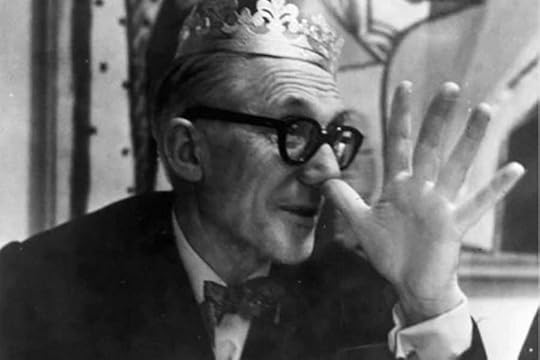 “There’s no point in being grown up if you can’t be childish sometimes” – The Fourth Doctor
“There’s no point in being grown up if you can’t be childish sometimes” – The Fourth DoctorRhode’s work is really worth checking out. I may be an artistic abecedarian – I’ve just this minute learned that awesome word – but I was reminded of another artistic hero, Ellsworth Kelly, who was influenced by Brâncuși’s simplification of natural forms and converted leaves and landforms into monumental, geometric, often monochromatic, shapes.
Finally emerging from the Festival, I find that I’ve managed to make it to a couple of shows by playwrights and writers I admire. There’s a feeling that they’re grappling with weighty issues in ambitious shows and seeing if they will fit into the shape of a piece of art. my visits to the Book Festival mean I’ve got a new batch of books to start reading. Therein, people and protagonists will be trying to find meanings and impose narratives on chaos.
 No! Bad chaos!
No! Bad chaos!Unrelatedly, I guess I’ll have to catch up on the news now…
The Five Stages Of #Brexit:
1. £350M per week for the #NHS
2. Empire 2.0
3. Selling innovative jam
4. Not a #MadMax-style #dystopia
5. Not the #endoftheworld
5A. Not being chained to a rock and having your liver pecked out for eternity. pic.twitter.com/YXR8WH6otv
— Ricky Monahan Brown (@ricky_ballboy) August 28, 2018
Share this:





August 22, 2018
Judge Dread
Clearly, I was spoiled for news stories to cover last week. Even this week, and more specifically today, a lot of things I’m interested in have been cropping up.
Trump‘s been in the news a bunch, but I’m not going to spend any time on the details of that. I mean, who’s got the bandwidth to constantly maintain the rage?
 A: This guy?
A: This guy?No, the most interesting thing I learned about Trump this week keyed into my interest in the amount of time we spent at work.
[Waste your time at work with the Apoplexy Tiny Letter.]
However, also, I have to say, 20 hrs a week should be the endpoint of a fully automated economy. All that spare time for craft, relationships, self-development, citizenship. Trump scratches his wizened balls. We can do better. https://t.co/5TnrGjunoH
— Pat Kane (@thoughtland) August 21, 2018
Apparently, Michael Cera plays the Young Donald Trump. You know Trump would love that, right? The character playing his acoustic guitar like a manic pixie dream boi?
From my days as an attorney, the thought of a 20-hour week seems like a crazy dream. Six years later, I’ve got to think that it still is. Surely Trump’s various activities have added – on average – around ten hours to the working week of every lawyer in America.
 Rudy Giuliani realises why he’s lost his mojo
Rudy Giuliani realises why he’s lost his mojoWhen I would dream about the day that the legal bar-based closed shop would collapse and my job would be shipped off to an emerging economy, I always reckoned that becoming a barber would be a good gig. Of course, I got the sack and had a stroke before I could achieve that impossible dream.
 ‘We have mastered scissors anyway, you bouffant-ed fool!’
‘We have mastered scissors anyway, you bouffant-ed fool!’Around six years too early, it seems. This morning on the Today Programme, they were talking about how algorithms are infiltrating the law and A.I. is playing an increasing role in the legal world. Not just in checking contracts – some of the more advanced NYC firms were already punching the provisions of term sheets into templates and spitting out early drafts of complex agreements when I was practicing. No, they’re talking about algorithms predicting court outcomes, and even making judgments. The Lord Chief Justice of England apparently doesn’t believe that lawyers and judges will be replaced by algorithms. Nevertheless, Today said,
some lawyers are warning that the U.K. should put protections in place to make sure that algorithms aren’t one day allowed to make court rulings.
[image error]
August 14, 2018
Digesta Plaga #12
Get out the bunting, Maude – a mere six months after the last one, it’s time for a new Stroke News Digest!
 Alright, settle down.
Alright, settle down.[Check out the Apoplexy Tiny Letter for your soundtrack before settling in.]
1. Sleeper
A month ago, I was writing here in the blog about research that had
linked shift work to obesity, diabetes and other metabolic disorders that can raise the risk of heart disease, stroke and cancer.
So what we all need is a good night’s sleep, right? WRONG! Or, RIGHT! Or…
 Seriously man, you slept through that?
Seriously man, you slept through that?According to this report on a study recently published in the Journal of the American Heart Association
[m]ore than seven or eight hours a night of sleep is associated with higher risk of premature death
and
staying in bed for more than 10 hours was… linked to a 56% increased risk of death from stroke.
But just like in the discussion of sleep patterns in Nightshift, it pays to read beyond the headline. The lead researcher, Dr Chun Shing Kwok of Keele University’s Institute for Science and Technology in Medicine, explains that there are any number of influences on our sleep patterns that may lead to us spending more time in bed, including the need to care for family members, irregular working shift patterns, mental illness, and the 24-hour availability of commodities in modern society.
I’ve got to admit, the 24-hour availability of commodities is something I miss from NYC. Anyway, if you have the good fortune to get a chance to stay in bed for 10 hours, go for it, I say.*
2. Omega
 “Omega will make me feel better? I’m not buying it.”
“Omega will make me feel better? I’m not buying it.”Maybe you’re getting some extra sleep and reckon you should be doing something to offset that terribly unhealthy habit. Like taking omega-3 supplements, for example.
Don’t bother, another new study says. In this case, the supplements won’t protect you from stoke, heart attack, or early death.
The belief that [omega-3 supplements protect] the heart has spread – and is promoted in the marketing of the supplements – because the results from early trials suggested the capsules had cardiovascular benefits.
A finding that this isn’t the case didn’t come as a terrible surprise to me. At a recent blood pressure check-up at my doctors’ office, the nurse couldn’t find much wrong with my post-stroke healthy lifestyle and was reduced to telling me to eat more oily fish. Not the supplements.
 “I’m gonna need all you got of this.”*
“I’m gonna need all you got of this.”*The lead author of this particular study said there was not enough trial evidence to show whether or not eating more oily fish is beneficial – although she suspected it probably is, because extra fish replaces something else in the diet which may be less good for you.
Another professor of cardiovascular medicine says save the money you’d spend on supplements and spend the money of vegetables instead.
3. Get Salty?
A final recent study in this Stroke Digest, and this one’s a biggie, covering 90,000 people in more than 300 communities in 18 countries. It was carried out by the creepily-named Population Health Research Institute and McMaster University in Canada.
 “Where you can learn to take free kicks like John McMaster!”*
“Where you can learn to take free kicks like John McMaster!”*I was quite excited about this one, because not so long ago, a New York Times article about cooking with salt changed my relationship with the condiment. Growing up in a family where we always adhered to the prevalent medical advice about cutting down on salt, I had always kind of kept it at arms’ length. It turns out that it really does help with one’s cooking.
The new study
suggests campaigns to persuade people to cut down may only be worthwhile in countries with very high sodium consumption, such as China.
Great news, right? WRONG! Or, RIGHT! Or…
 “You’ve done this bit. Watch yourself.” – Ed.
“You’ve done this bit. Watch yourself.” – Ed.It turns out that two years ago, the same team published a study with similar results, that was panned as “bad science”. This new one has been attacked, inter alia, for not accurately measuring the amount of sodium in people’s urine.
So, in order to live forever, apoplectic.me suggests* that you:
Get more sleep.
Sleep less.
Take omega-3 supplements.
Don’t take omega-3 supplements.
Consume less salt.
Consume as much salt as you like.
Good luck!
__________________________
*Disclaimer: Stroke Bloke is not a trained medical professional.
*Disclaimer: Stroke Bloke is not a trained medical professional.
*Disclaimer: You are not John McMaster. C’mon. Look at yourself.
*Disclaimer: Stroke Bloke is not a trained medical professional.
Share this:





August 7, 2018
Bad Behaviour
For a couple of weeks now, after considering why people are working longer and later hours notwithstanding the deleterious effect on their health, I’ve been wanting to consider the wider question of Why do companies do bad things?
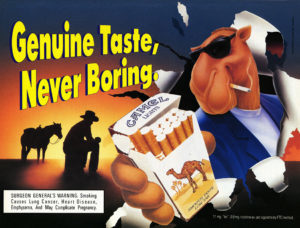 “Relax kids, it’s all cool. Here, have one of these.”
“Relax kids, it’s all cool. Here, have one of these.”[Kick back with more whimsy and a blog soundtrack at the Apoplexy Tiny Letter.]
Recently, things have fallen into place to make this happen. First, I’ve been revisiting some old stuff I wrote about the tragic death of Moritz Erhardt. Moritz has kind of haunted me ever since I read about his death after pulling a series of all-nighters as an intern with Bank of America Merrill Lynch (1, 2, 3, 4).
That is, he pulled a series of all-nighters and died.
I read about it in the aftermath of a catastrophic hemorrhagic stroke.
How was that allowed to happen? Why would Moritz think it was OK that he could be expected to do this? Also, I finally got around to listening to a recent episode of Radio 4’s The Bottom Line, entitled Why Do Companies Do Bad Things?
 RAWK’N’ROLL, STROKE BLOKE!!!
RAWK’N’ROLL, STROKE BLOKE!!!I suffered a catastrophic stroke two days after losing my job as a financial lawyer in New York City. Now, I don’t remember doing anything specific that one could point to as A Bad Thing – at least in that relation. In a prior job I had recused myself from transactions that directly funded arms manufacturers, for example.
In my final years as a lawyer, though, I was a securitisation attorney – which means blah blah blah blah. And these years straddled the Financial Crisis of 2007-2008 [Shurely 2007-2018? – Ed.]
![AC/DC rule, man! [See posts passim.]](https://images.gr-assets.com/hostedimages/1539336978ra/26437868.gif) RAWK’N’ROLL, STROKE BLOKE!!!Now, that crisis was precipitated by the bursting of what came to be called the Subprime Mortage Bubble, to which the securitisation of mortgages contributed. As it happens, my specialisation was in the securitisation of trade receivables, but that’s not important right now. I’m just making the point that I was standing on the sidelines in the aftermath as financial lawyers were trying to figure out how to be least affected by the resulting tightening of regulations. Also, when bankers went back to trying to loosen underwriting standards so they could generate more deals and fees.
RAWK’N’ROLL, STROKE BLOKE!!!Now, that crisis was precipitated by the bursting of what came to be called the Subprime Mortage Bubble, to which the securitisation of mortgages contributed. As it happens, my specialisation was in the securitisation of trade receivables, but that’s not important right now. I’m just making the point that I was standing on the sidelines in the aftermath as financial lawyers were trying to figure out how to be least affected by the resulting tightening of regulations. Also, when bankers went back to trying to loosen underwriting standards so they could generate more deals and fees.
[image error]RAWK’N’ROLL, STROKE BLOKE!!!
In other words, while people were trying to return to the way they had been doing things that had contributed and would continue to contribute to the impoverishment of people around the world. Why would they do this? They mostly seemed like nice people would liked nice wines and nice karaoke parties.
Perhaps even more egregiously, why would the people who work at car companies seek to have their products dodge emissions tests? These were the questions that The Bottom Line was trying to answer. Also, Why do broadcasters deceive? Which was quite clever, because asking the question sort of raised Aunty Beeb above the fray.
 “RAWK’N’ROLL, STROKE BLOKE!!!” – BBC Top Of The Pops
“RAWK’N’ROLL, STROKE BLOKE!!!” – BBC Top Of The PopsOr did it? If Aunty could hover in immaculate judgement, why was one of the first directives uttered by the panel of a consultant and business school professor, a lawyer defending corporations and executives, and a convicted cheat and fraudster that
– We must distinguish accidents and cockups from conspiracies and intentional behaviour
Y’see, the listener learnt as the programme went on that every foamy bark canker from a little acorn must grow.
 RAWK’N’ROLL, STROKE BLOKE!!!
RAWK’N’ROLL, STROKE BLOKE!!!It was the convicted criminal Nick Leeson who was most Old Testament in his insistence that individuals must be punished for their misdeeds within corporations. At first blush, this seems to go against the feeling that arises from believing that corporate crime arises from good people doing bad things, bad decisions being made in groups and becoming normative, and subordinates knowing not to bring problems publicly to the attention of their bosses – all factors that the programme raised.
On the other hand, might it be that it is excusing and normalising the bad behaviour of the functionaries that allows us, by extension, to excuse the bad behaviour of executives and corporations? And politicians? I dunno. I’m beginning to think that this might be better examined in a 600-page satirical novel than a 600-word blog post. So while I’m working on that, why not check out the shredding at the end of this awesome track from my top tunes of 2017?
RAWK’N’ROLL, STROKE BLOKE!!!
Share this:





July 25, 2018
Land Seer
On the bus into Edinburgh’s New Town yesterday, I was reflecting on a short story I’ve been working on, a historical fiction about the Ross-shire Sheep Riots (also known as the – ten-day long – Year Of The Sheep). As the name suggests, it’s set in Scotland. My work tends to be set most often there, or in NYC, or in some imagined hybrid of the two.
 Where presumably everyone looks like this
Where presumably everyone looks like this
Don’t worry – I’m going somewhere with this.
Check out the Apoplexy Tiny Letter for a soundtrack while I wend my way.
By dint of their setting, many of my stories – and long-suffering readers of the blog won’t be surprised by this – end up being not just about their primary through line, but also having a kind of B-line about what Scotland is.
Perhaps that’s also not surprising, because borders and places where ideas meet, places where there’s perhaps a mental incongruity, are interesting places to mine artistically. Scotland is both a nation and not, for the purpose of international law, a State. And there’s a tension and a friction in living that.
 Confused Aberdeen FC fans reenact the Ross-shire Sheep Riots
Confused Aberdeen FC fans reenact the Ross-shire Sheep RiotsYes, I know Aberdeen’s 120-odd miles from Dingwall. But I’m just a typical Central Belt city-slicker, amn’t I?
I think the reason I was thinking about all this was because I was on my way to Monarch of All it Surveys? a talk at the National Gallery of Scotland by Dr Jonathan Murray of the Edinburgh College of Art considering the history and enduring cultural resonance of Edwin Landseer’s 1851 painting The Monarch of the Glen.
 You know it, right?
You know it, right?Yes, you know it. It was purchased by distillers Dewar and Sons in 1916 and used as their trademark for many years. It’s also been used on the label of tins of Baxter’s Royal Game soup.
But maybe you weren’t born within a ladle’s length of the Baxter’s factory in Fochabers. And maybe your go-to well whisky for over a decade wasn’t the Dewar’s whisky that’s so ubiquitous in New York City.
 Ooh, somestag’s gone upmarket!
Ooh, somestag’s gone upmarket!As an academic and critic in film, Jonny Murray noted the reference to Landseer’s image at the climax of the 2006 film, The Queen. Also, that Peter Blake painted a version, After ‘The Monarch of the Glen’ by Sir Edwin Landseer for Paul McCartney’s Mull of Kintyre property. And that Peter Saville – of New Order album covers fame – painted another version.
I learned that Landseer, critically and commercially successful in his time, had quickly fallen out of favour with the art establishment after his death. And that, his work has been somewhat re-evaluated in more recent years, with the National Galleries of Scotland acquiring the painting from the multinational drinks company Diageo at half its appraised value after a public fundraising campaign.
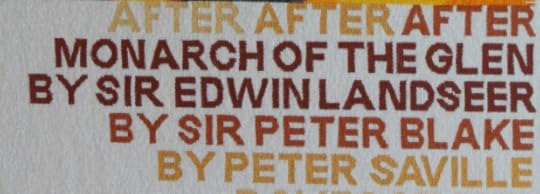 Let’s talk about this After
Let’s talk about this AfterDr Murray also made reference to more recent and sceptical engagements with The Monarch of the Glen by contemporary Scottish artists like Ross Sinclair who, in a commission from Aberdeen Museum and Gallery, created an installation called Ross Sinclair versus Sir Edwin Landseer which includes a pop song containing the lines
Edwin Landseer died in 1873
I don’t know what he means to you
But I’ll tell you what he means to me
Sinclair’s thoughts weren’t entirely complementary, it turns out.
Even if it doesn’t sound like he quite went quite the full “Chuck D-On-Elvis”
At the end of the talk, members of the audience were presented with postcards from the National Galleries, asking us What do you think is the relevance of [The Monarch of the Glen] to Scotland today?
I think that it’s only an illustration of the past today’s Scotland emerges from. The Monarch of the Glen was painted less than sixty years after the Ross-shire Sheep Riots. Landseer was painting a picture of an imagined Highlands commissioned as part of a series of three panels to hang in the Palace of Westminster in London; the Refreshment Rooms of the House of Lords, to be more exact.
Once they were completed the House of Commons refused to grant the £150 promised for the commission
[image error]They’ve got form, is all I’m saying
The painting went on to be held in a series of private collections, and it sold widely in reproductions in steel engraving thought the 19th century. Landseer had a ready audience among the landed and hunting set for his paintings depicting The Hunt.
What’s interesting to me this week is that the setting of the painting – an idealised portion of Scotland that could be Glen Africc or Glenfeshie or Glen Orchy or Glen Quoich – is empty. This Scotland of Edwin Landseer and his patron Walter Scott contains a Highlands which fills two-thirds of the total area of Scotland. That Highlands contained almost half the population of the country just a few years after the Ross-shire Sheep Riot, and had less than a fifth of the population when The Spectator article linked above was written, to allow room for sheep and hunting estates and the Balmoralisation of the area.
 “Hunting? What the who now?”
“Hunting? What the who now?”Now, the Highlands and Islands are subject to various attempts at local community buyouts, and it’s recognised that what is seen at the natural, rugged beauty of the Highlands isn’t as unnatural and untouched as we might believe.
So, I suppose that’s my answer to the National Galleries’ question, What do you think is the relevance of [The Monarch of the Glen] to Scotland today? It’s a picture depicting a cautionary tale.
But when we’re talking about cultural resonance and the depiction of Scotland, I’m glad that I grew up in an era when I could be exposed to something Jonny Murray has written about in the day job – Comfort and Joy and the other films of Bill Forsyth – and more recently I’ve been able to read books like those of Alan Warner. In a country where film and literature is set in, and comes from, places that are recognisable to a Scottish kid.
[image error] “What do you think is the relevance of this picture to Scotland today?“
If you have any reflections on Landseer’s painting, the National Galleries of Scotland are interested to hear about them at the link above. Dr Jonathan Murray’s talk on The Monarch of the Glen is available in its entirety below.
@eca_edinburgh Dr Jonny Murray gave a brilliant talk today @NatGalleriesSco about the #visualculture of #MonarchoftheGlen #lunchtimetalk watch it here: https://t.co/rpz9HdxGLp






